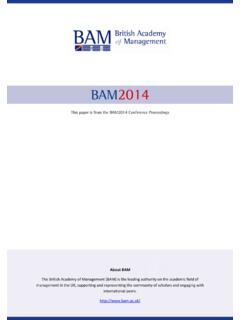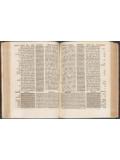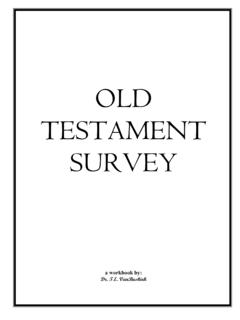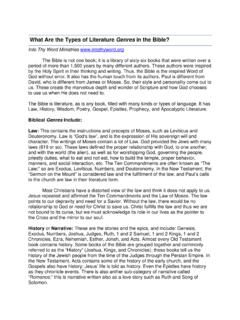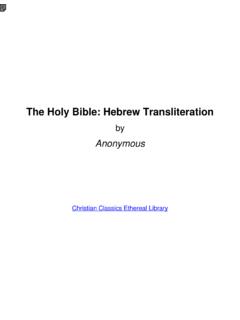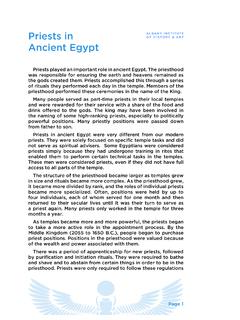Transcription of THE CODEX SINAITICUS - British Library
1 THE CODEX SINAITICUS . T. S. PATTIE. T H E CODEX SINAITICUS of the Greek Bible, even though it has lost over 300 leaves, is still the earliest complete New testament , and is the earliest and best witness for some of the books of the Old testament . It was written in the first half of the fourth century, when Christianity became the official religion of the Roman Empire, when all the books of the Bible were collected in one volume for the first time, and the CODEX (our modern sewn book) achieved its final victory over the roll, a victory only now challenged by the glued book. This priceless treasure was purchased in 1933 from the Soviet Government who were in desperate need of foreign currency.
2 The price paid was ; ioo,ooo, a sum comparable in magnitude, allowing for infiation, with the j 1,763,000 raised in 1971 by the National Gallery to acquire Titian's Death ofActaeon. The acquisition of the manuscript aroused such interest and excitement that the British Government contributed 39,319 to match the sum raised by public subscription. The manuscript itself was first identified by Constantine Tischendorf, an accurate biblical scholar and tireless traveller in search of manuscripts. In his own words :^. It was at the foot of Mount Sinai, in the Convent of St. Catherine, that I discovered the pearl of all my researches.
3 In visiting the Library of the monastery, in the month of May, 1844, I Per- ceived in the middle of the great hall a large and wide basket full of old parchments; and the librarian, who was a man of information, told me that two heaps of papers like these, mouldered by time, had been already committed to the flames. What was my surprise to find amid this heap of papers a considerable number of sheets of a copy of the Old testament in Greek, which seemed to me to be one of the most ancient that I had ever seen. The authorities of the convent allowed me to possess myself of a third of these parchments, or about forty-three sheets, all the more readily as they were destined for the fire.
4 But I could not get them to yield up possession of the remainder. The too lively satisfaction which I had displayed had aroused their suspicions as to the value of this manuscript. The picture of the leaves of the CODEX SINAITICUS lying in a basket about to be burned receives some general confirmation by a report by V. N. Beneshevich^ that he had heard from the steward Polycarp in 1908: 'Quite recently, in order to get rid of "rubbish", they heated the bread oven with old books, among which were very rare editions.'. Fig. I. CODEX SINAITICUS . Double opening: end of Gospel of Luke and beginning of Gospel of John.
5 Each page written in four columns Tischendorf took back to Frederick Augustus II of Saxony, who had sponsored his journey, the manuscripts he had collected including the 43 leaves from Sinai which he called the CODEX Friderico-Augustanus in honour of his patron. All these manuscripts were deposited in the University Library , Leipzig, where they still are. He visited the monastery for the third time on 31 January 1859. On 4 February the steward entertained him in his cell and, resuming a former conversation, said ? 'And I too have read a SeptUa- gint' ( Greek Old testament ). He then brought out a bulky kind of volume, wrapped up in a red cloth and laid it before me.
6 I unrolled the cover, and discovered, to my great surprise not only those very fragments which, fifteen years before, I had taken out of the basket, but also other parts of the Old testament , the New testament complete, and in addition the Epistle of Barnabas and a part of the Pastor of Hermas. Full of joy, which this time I had the self-command to conceal from the steward and the rest of the community, I asked, as if in a careless way, for permission to take the manuscript into my sleeping chamber to look over it more at leisure. There by myself I could give way to the transport of joy which I felt.
7 I knew that I held in my hand the most precious Biblical treasure in existence - a document whose age and importance exceeded that of all the manuscripts which I had ever examined during twenty years' study of the subject. Tischendorf borrowed the manuscript and presented it to the Emperor of Russia, believing in his excitement that he had the monks' agreement to do so. It is likely enough that Tischendorf and the head of the monastery, Cyril, Archbishop-Elect of Sinai, had a private agreement to this effect, but when the proposal came to the ears of Cyril's enemies ^. itxr roexe b ceo YKX. nxcxtrixcHMC.
8 KX|-roKXTD| Kei N Mc^. XHM. 2. CODEX SINAITICUS . Page from the Psalms written in two columns. Psalm 23 ('KB') and other psalms with corrections he was forced in self-defence to say that there was no intention of giving away the manu- script. This impossible situation was regularized by the Russian diplomatic service ten years later, in 1869, by an agreement with the new Archbishop of Sinai, Callistus, in which the monks agreed to donate the manuscript to the Emperor, and the Emperor gave the monks some money and some decorations. However, the monks on Sinai still resent the way in which their Treasure was given away.
9 Once the manuscript was in St. Petersburg Tischendorf gave it the name of CODEX SINAITICUS Petropolitanus, in honour of its place of discovery and its place of residence. He prepared a luxurious edition complete with scholarly commentary, in 'facsimile type'. of the 346^ leaves, published in 1862 at Russian expense. The 43 leaves at Leipzig he had already published. Both parts were pubhshed in 1911 in collotype facsimile by Kirsopp and Helen Lake. The text of our Bible is supremely well attested, but there are a few puzzles. One of these is the ending of the Gospel of Mark, which has two main forms, the long ending and the short ending.
10 The SINAITICUS agrees with other early manuscripts like the Vaticanus in having the short ending. Another puzzle is the story of the adulterous woman (John 7: 53-8: 11) which some manuscripts place after John 7: 36, or 7: 52, or 21: 24, or even after Luke 21: 38. The SINAITICUS , like the Vaticanus, omits the adulterous woman altogether. Are we to assume that there was at an early date an editorial decision to leave out both of these sections, this decision being reflected in the SINAITICUS and Vaticanus, but not in the text which became standard in the Orthodox Church and thence in the Authorized Version ?

